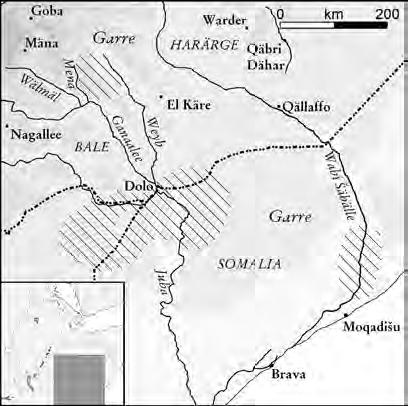
 Please wait...
Please wait...
-
@Everything Ethiopia 1+ years agoEverything there is to Ethiopia from around the web!
Garre (also referred to in the literature as Garreh, Gerra, Gherra, Garri etc.) is a Somali clan found in southern Somalia, Ethiopia and Kenya. Ac-cording to Lewis (1955:27), the G. inhabit at least four different locations: the lower reaches of the Šäbälle river near Awdegle, in southern Somalia; two areas in Ethiopia: around the border town of Dolo in the Upper Juba and bordering and inter-mingled with the ÷Arsi in an area between the Wabi Gestro (Wäyb) and the Wabi Mäna; and further to the south in northern Kenya between the Aguraan and Digodia Somali.
Except for those Garre living along the lower course of the Šäbälle river in southern Somalia and who speak a distinctive Somali variety, all the other G. are to a greater or lesser extent or-omized and are part and parcel of those groups of “Proto-Rendille-Somali” culture which, accord-ing to Schlee (1989), have undergone “Boorani-zation” after the 16th cent. While Booranization is apparently complete as far as language is concerned, the G. consider themselves and are considered Somali.
As to the agnatic position of the G. within the Somali clanic families, Colucci (1924), followed by Lewis (1955), considered them to represent the numerically most important clan of the “pre-Hawiye” family, who had preceded the Haw-iye in a very early migration from the north of Somalia. Local traditions investigated by Mo-hamed Nuuh Ali (1985) and already referred to by Cerulli (1957) and Turton (1975) ascribe to the G. (or a part thereof) a central role in the “So-malization” of the Lower Juba and of the coastal area around its mouth. In the course of their migrations, the G. came into contact with the Northern-Swahili-speaking Bajuni of the Bajuni Islands (certain Bajuni sections claim a G. origin) and dominated the whole area until the Orma invasions of the 16th cent. The most important linguistic result of the G. presence in what is today southern Somalia and northern Kenya has been the Somalization of the Boni (or Aweera), a hunting and gathering group of a few thousands living in the forest belt stretching along the coast of the Indian Ocean, immediately to the south of the Somalia-Kenya border (Tosco 1994b). While nothing specifically links the Garre to the north, there does not seem to be any evidence either of an ancient southward migration, all pointing to a “southern” origin of the G. in an area of strong Oromo/Somali (and Rendille) interaction. The internal clan-structure of the G. supports this view: like many groups of the area, the G. divide themselves into two moieties, which among the G. are called Tuuf and Quran-yow; many almost identical names of sections are further found among the Rendille (cf. Schlee 1989 and Tosco 1994a).
Linguistically, the Garre of southern Somalia speak a distinctive variety of Somali (Tosco 1989), which Lamberti (1985) classifies within his highly heterogeneous “Digil group” of dialects (although, agnatically speaking, the G. have nothing to do with the Digil clanic family). Giving credit to the historical traditions referred to above, the language of the G. (i.e. of the G. of southern Somalia) finds its closest linguistic relative, not among any other Somali dialects, but in the Boni language. The most important and unique isogloss linking G. and Boni is the devoicing of initial /d/ and /g/ (whereby these G. call themselves Karre and their language Af-Karre). All the other G. groups, as anticipated, speak varieties of (Southern) Oromo.
Source:
Encyclopaedia Aethiopica
 Please wait...
Please wait...
 Loading content ...
Loading content ...
 Loading content ...
Loading content ...
 Please wait...
Please wait...
Similar topics
Similar topics
 Please wait...
Please wait...


